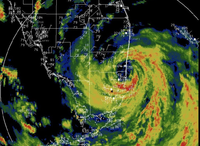Conversion in progress ...
Please wait while we generate your PDF
2023 HURRICANE PREPAREDNESS GUIDE
Prepared not Scared!
Welcome to Northeast Florida! Whether you've just moved here or are contemplating the idea, one aspect you've probably heard a lot about is our hurricane season. But don't worry—it's not as daunting as it may seem, especially when you're well-prepared. In this guide, we'll break down everything you need to know about the hurricane season, from understanding hurricanes themselves to how to prepare and recover. Remember, knowledge is power, and the more you know, the more you can enjoy the beauty and charm of our region without undue worry.
2023 Hurricane Season Outlook
In the Atlantic Ocean, the hurricane season officially runs from June 1st to November 30th. While it's true that hurricanes can occur outside of this period, about 97% of tropical activity happens within these dates. The season tends to peak from late August through September. However, nature doesn't always stick to a schedule, so it's important to stay aware throughout the season.
NOAA predicts 14 to 19 named storms.
In 2023, the Atlantic hurricane season is expected to be above-average, with 14-19 named storms, 6-8 hurricanes, and 3-5 major hurricanes (Category 3 or higher). This is based on the latest forecast from the National Oceanic and Atmospheric Administration (NOAA). The effects of a potential El Nino and conditions from West Africa, along with warmer Atlantic and Caribbean waters, could influence hurricane activity.
NOAA is enhancing their forecasts, with a new system providing a two-day earlier hurricane warning and a 10-15% improvement in tracking accuracy, enhancing our safety during the season.
Understanding Hurricanes
Hurricanes are tropical cyclones with sustained winds of 74 miles per hour or greater that form over warm ocean waters. You might be wondering, why Florida? Well, Florida's long coastline and geographical position make it a prime target for these tropical systems. However, not every tropical storm escalates to a hurricane, and not every hurricane that forms will make landfall. The key is to stay informed and understand the trajectory and severity of these systems.
7 Stages of the Hurricane Timeline
Every year from 2012 to 2022 has had at least one hurricane that affects Florida.
01

Formation (Tropical Disturbance)
Hurricanes begin as tropical disturbances over warm ocean waters with temperatures of 79.7 degrees Fahrenheit or higher. These disturbances, which often form off the west coast of Africa, are large systems of thunderstorms that have a defined circulation.
02

Tropical Depression
If the tropical disturbance continues to organize and winds pick up to between 23-38 mph, it becomes a tropical depression. Meteorologists assign it a number (e.g., "Tropical Depression 12").
03

Tropical Storm
If winds reach between 39-73 mph, the system is upgraded to a tropical storm and given a name (e.g., "Tropical Storm John").
04

Hurricane:
If winds reach 74 mph or higher, the storm becomes a hurricane. The storm is further classified into categories 1-5 based on the Saffir-Simpson Hurricane Wind Scale, which considers the storm's sustained wind speed.
05

Approaching Landfall
As a hurricane approaches land, it can cause severe coastal flooding, known as storm surge. The strength of the storm surge and the impact of the hurricane's winds are greatly influenced by the storm's size, speed, intensity, and the geography of the coastal region.
06

Landfall
This term is used when the hurricane's eye crosses onto land. At landfall, a hurricane can cause significant damage from high winds and flooding.
07

Post-landfall/Dissipation
After landfall, a hurricane weakens due to friction and a lack of warm, moist air. It typically becomes a tropical storm, then a tropical depression, and eventually dissipates. However, it can still cause significant damage and flooding, particularly if it moves slowly or stalls over an area.
Understanding Hurricane Categories
Hurricanes are classified into five categories based on their wind speed known as the Saffir-Simpson Hurricane Wind Scale.
CAT 1 (74-95 mph)
While they're the weakest hurricanes, Category 1 storms can still cause some damage to buildings, as well as power outages due to downed power lines and tree branches.
CAT 2 (96-110 mph)
These storms can cause significant damage to homes and other buildings, with the potential for power outages that could last from several days to a week.
CAT 3 (111-129 mph)
A Category 3 storm is considered a major hurricane. These hurricanes can cause serious damage to homes, including the removal of roof decking and gable ends. Electricity and water could be unavailable for several days to weeks after the storm passes.
CAT 4 (130-156 mph)
These major hurricanes can cause catastrophic damage. Homes can suffer severe damage with loss of most of the roof structure and/or some exterior walls. Most trees will be snapped or uprooted and power poles downed, isolating residential areas. Power outages will last weeks to possibly months. Most of the area will be uninhabitable for weeks or months.
CAT 5 (157+ mph)
The most severe category of hurricane, a Category 5 storm can level houses and destroy buildings with heavy, wind-tossed debris. Power outages will last for weeks to possibly months, and most of the area will be uninhabitable for the same period.
Understanding Storm Surge and Its Dangers
Storm Surge
Storm surge is a significant component of a hurricane's destructive power. It can cause rapid flooding and significant damage, especially in coastal areas. It can also trap people in their homes or in other structures, leading to a high number of fatalities. Historically, storm surge has been the leading cause of death in hurricanes.
Check out the link below for Evacuation and Storm Surge information.
Preparing for Hurricane Season
Preparation is key when it comes to hurricane season.
Here are some steps to ensure you're ready:.
Before the Hurricane
Preparing an Emergency Kit:
Gather supplies in case you have to evacuate quickly. Essential items include bottled water, non-perishable food, flashlights, batteries, a first aid kit, necessary medications, cash, important documents (in waterproof containers), a battery or hand-crank radio, and personal hygiene items.
Creating a Family Disaster Plan:
Decide on a meeting place and an out-of-town contact everyone can check in with. Make sure every family member knows the plan, and practice it together.
Securing Your Home:
Install hurricane shutters or pre-cut plywood for windows. Secure loose objects in your yard. Trim trees to reduce the risk of broken branches.
*See Fortifying Your Home section below for tips*
Checking Insurance Coverage:
Review your homeowners insurance policy to ensure you have enough coverage to repair or even replace your home if it's damaged. Remember that flood damage is not usually covered by standard homeowners insurance.
Understanding Evacuation Routes:
Familiarize yourself with local evacuation routes and make transportation plans. If you don't have a car, plan how you will evacuate if necessary.
During/After the Hurricane
Staying Informed:
Keep a battery-powered or hand-crank radio on hand to listen for updates and instructions from authorities.
Staying Indoors:
Unless you're ordered to evacuate, stay indoors away from windows and glass doors to avoid injury from breaking glass.
Avoiding Flood Water:
Don't walk or drive through flood waters. Just six inches of moving water can knock you down, and one foot of water can sweep your vehicle away. Also, flood water may be electrically charged from underground or downed power lines, or may contain hazardous materials.
Checking on Neighbors:
If it's safe to do so, check on your neighbors, particularly those who are elderly, have young children, or have disabilities. They may need extra help before, during, or after the storm.
Cleaning Up Safely:
Be cautious during clean-up. Wear protective clothing, including rubber gloves and rubber boots. Avoid overexertion and take breaks. Be wary of wildlife that may have been displaced by the storm. If you see downed power lines or smell gas, contact your utility company immediately.
🐶🐱 Pets in Hurricanes 🌀
Don't forget about your furry friends! Make sure your emergency plan includes your pets. Have a pet emergency kit ready with food, water, medications, and familiar items to comfort them. Also, remember that not all emergency shelters accept pets, so identify pet-friendly hotels or shelters in advance.
Hurricane Preparation Checklist

To help you prepare for a potential hurricane, we've created a checklist of essential items and tasks. Please review this list and tick off the items you already have or actions you've completed. This will allow you to clearly see where you might need to enhance your preparation efforts.
1. Medication and Medical Supplies:
2. Power and Communication:
3. Entertainment:
4. Personal Documents:
5. Pet and Service Animal Supplies:
6. Food and Water:
7. Clothing and Protective Gear:
8. Vehicle Preparation:
9. Household Preparation:
10. Evacuation Plan:
Staying Informed
When it comes to hurricanes, information is power. Staying updated about storm developments can make the difference between being caught off guard and having enough time to prepare. Here are some resources you can use to stay informed and monitor approaching storms:
1. National Hurricane Center (NHC):
The NHC is the official source for reliable and timely hurricane forecasts in the United States. You can visit their website at www.nhc.noaa.gov for the most accurate and up-to-date information about ongoing storms and potential hurricane threats. They also provide detailed storm tracking maps, forecasts, and warnings.
2. Local Weather Channels and News Outlets:
Local news stations often provide real-time updates and valuable information about how a hurricane might impact your specific area. They can provide important information about local evacuation orders, emergency shelters, and road closures.
3. Weather Websites and Apps:
MyRadar is a leading weather application that provides real-time updates and tracking for hurricanes. Along with others like Weather.com and AccuWeather, these platforms offer detailed weather forecasts, storm tracking, and emergency alerts. In particular, MyRadar stands out with its easy-to-use interface and comprehensive weather data, including real-time radar images, severe weather alerts, and hurricane tracking. It's a reliable tool for anyone in Florida or other hurricane-prone regions to stay updated about potential weather threats.
4. Social Media:
Many official weather organizations and local news outlets use social media platforms like Twitter and Facebook to post updates about weather conditions. This can be a quick and easy way to stay informed.
5. NOAA Weather Radio:
A battery-powered weather radio can be an invaluable tool during a hurricane, especially if power goes out. NOAA Weather Radio provides continuous broadcasts of the latest weather information directly from a nearby National Weather Service office.
A battery-powered weather radio can be an invaluable tool during a hurricane, especially if power goes out. NOAA Weather Radio provides continuous broadcasts of the latest weather information directly from a nearby National Weather Service office.
6. Family, Friends, and Neighbors:
Don't forget about the importance of staying connected with your local community. Family, friends, and neighbors can provide support and share information during a hurricane. Consider setting up a group text or email chain to stay in touch and help each other out as needed.
Fortifying Your Home
Immediate Actions For An Approaching Storm
When a hurricane is fast approaching, swift and effective measures are crucial to protect your home. With these immediate fortifications, you'll be well on your way to securing your home against the impending storm.
Sandbags
If you're in a storm surge area or flood-prone zone, sandbags can be a great way to protect your home from flooding. Placing them around doors, garage entries, and other vulnerable areas can help keep water out.
Plywood Shutters
If you don't have hurricane shutters, you can protect your windows using plywood. A thickness of at least 1/2 inch is recommended. Secure them well to the window frames to prevent wind from getting under them.
Clear the Yard
Bring in any outdoor furniture, toys, grills, or other objects that could be blown around by the wind. These can become projectiles in a storm and cause significant damage to your home.
Reinforce Your Doors
Brace your doors from the inside, particularly your garage doors, which can be especially vulnerable to high winds. A common way to brace doors is using a security bar, but even a plank of wood can help in a pinch
Cover Air Conditioning Units
If you have an external air conditioning unit, cover it with a tarp or plywood to protect it from flying debris.
Seal Vents and Openings
Close and lock all windows and doors. Seal any vents, outdoor electrical outlets, and other openings where wind could enter
Long-term Fortification
These long-term improvements can significantly increase your home's resilience to hurricanes, providing you with peace of mind and potentially saving you a lot of money in repairs in the event of a storm. They also have the added benefit of potentially increasing your home's value, and in some cases, lowering your home insurance premiums.
Wind-Resistant Doors and Windows
Investing in hurricane-resistant doors and windows can dramatically increase your home's resiliency to storms. These are designed to withstand high winds and flying debris.
Roof Reinforcements
Reinforce your roof with hurricane straps or clips. These devices connect your roof to the walls of the house, reducing the chance of it being torn off by high winds. When it's time to replace your roof, consider using wind-resistant shingles. (Florida homes built after 2001 are required to have hurricane clips).
Install a Generator
A standby generator can provide power to your home in the event of an outage. This can keep essential systems running, like your refrigerator and air conditioning.
Plant Wind-Resistant Trees and Shrubs
Some types of trees and shrubs are more resistant to wind than others and less likely to become projectiles. Plant these around your home for added protection.
Improve Drainage
Make sure your property has good drainage to prevent water from pooling around your home's foundation, which can cause damage over time.
Storm Surge Barriers
These structures are designed to prevent seawater from flooding your property during a storm surge. They can be as simple as a levee or seawall, or as complex as a mechanically operated barrier.
🌤️ After the Storm 🌈
Hurricanes leave behind a path of destruction and the recovery process can be a challenging time. Here are some steps you should consider taking after a hurricane has passed:
1. Safety First:
Be aware of potential hazards like fallen power lines, gas leaks, and structurally compromised buildings or roads.
2. Assess the Damage:
Once it's safe, carefully assess the damage to your property. Take photos or videos to document the damage for insurance purposes. Be careful of any potential hazards such as broken glass or exposed nails.
3. Contact Your Insurance Company:
Notify your homeowners or renters insurance company as soon as possible. They can guide you through the process of filing a claim for any damages your property may have suffered.
4. Begin Clean-Up:
Begin the clean-up process. This may involve removing water, drying out your home, sorting out salvageable from unsalvageable belongings, and preventing mold growth. Remember to wear protective clothing during clean-up, especially if you're dealing with floodwater residue or mold.
5. Seek Assistance:
There are many local and national organizations that provide help after disasters. This could be anything from cleanup assistance to food and water supplies. The Federal Emergency Management Agency (FEMA) also provides assistance to individuals and communities recovering from disasters.
6. Repair and Rebuild:
Depending on the extent of the damage, you may need to make significant repairs to your home or even rebuild. Be sure to use licensed contractors and to obtain any necessary permits.
7. Take Care of Your Mental Health:
The aftermath of a hurricane can be a stressful and traumatic time. Don't neglect your mental health. Reach out to support systems like friends, family, or mental health professionals. Community organizations and faith-based groups can also provide support and resources.
Remember, recovery takes time. Be patient with yourself and others, and ask for help when you need it. It's during these challenging times that communities often come together and show their strength.
Important Contacts
National Services:
- FEMA:
Contact: 1-800-621-3362
Website: DisasterAssistance.gov - Red Cross:
Contact: 1-800-733-2767
Website: www.redcross.org - Florida Division of Emergency Management:
Contact: 850-815-4000
Website: www.floridadisaster.org - Salvation Army:
Contact: 1-800-SAL-ARMY
Website: www.salvationarmyusa.org - United Way:
Contact: Dial 211
Website: www.unitedway.org - Florida Department of Health:
Contact: 1-877-888-7468
Website: www.floridahealth.gov - Florida Department of Financial Services:
Contact: 1-877-MY-FL-CFO (1-877-693-5236)
Website: www.myfloridacfo.com - Florida Public Utilities:
Contact: 800.427.7712
Website: www.fpuc.com - Florida Insurance Commissioner:
Contact: 850-413-3140
Website: www.floir.com
Florida County Emergency Management Services:
- Nassau County:
Contact: (904) 548-0900
Website: www.onenassau.com - Duval County:
Contact: (904) 630-2472
Website:www.coj.net - Baker County:
Contact: (904) 259-2861
Website: www.bakercountysheriffsoffice.com - Clay County:
Contact: 1-877-CLA-Yeoc (1-877-252-9362)
Website: www.claycountygov.com - St. Johns County:
Contact: (904) 824-5550
Website: www.sjcemergencymanagement.com - Putnam County:
Contact: (386) 329-0380
Website: main.putnam-fl.com - Flagler County:
Contact: (386) 586-5111
Website: www.flagleremergency.com - Volusia County:
Contact: (386) 254-1500
Website: www.volusia.org
As always, if you are in a life-threatening situation, call 911 immediately.
Conclusion
Living in Northeast Florida means experiencing the beauty of the Atlantic coastline, the warmth of the community, and yes, the reality of hurricane season. But with preparation and the right mindset, there's no reason for it to overshadow the many benefits of life here. From understanding what goes into an emergency kit to knowing how to secure your home and formulating an evacuation plan, being prepared can alleviate much of the stress associated with the hurricane season.
Remember, with the right preparations and a calm, informed approach, hurricane season is a manageable part of life in our beautiful corner of the world. So, stay informed, stay prepared, and enjoy all that our wonderful region has to offer. Here's to a safe and enjoyable 2023 hurricane season!


